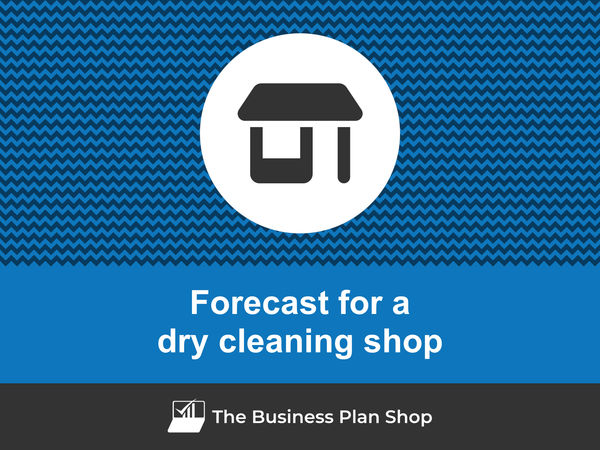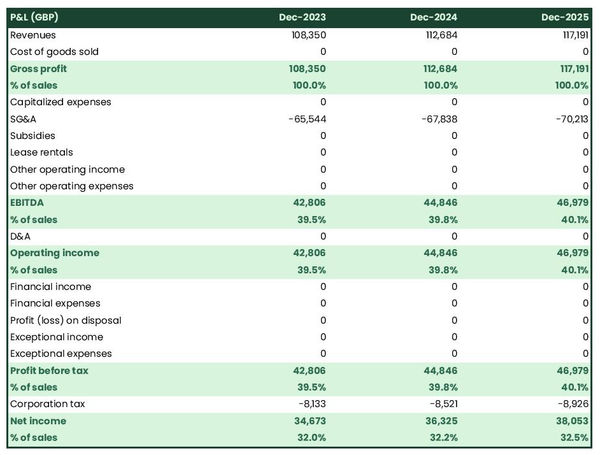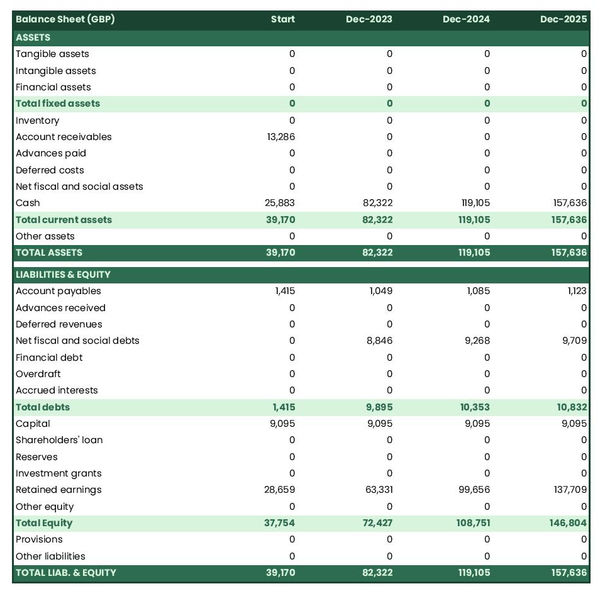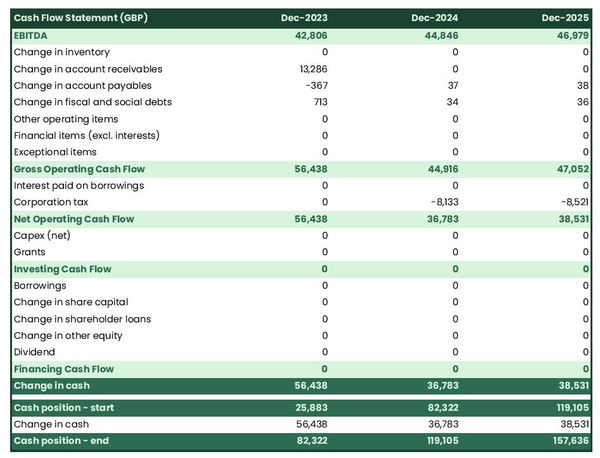How to create a financial forecast for a dry cleaning shop?

Creating a financial forecast for your dry cleaning shop, and ensuring it stays up to date, is the only way to maintain visibility on future cash flows.
This might sound complex, but with the right guidance and tools, creating an accurate financial forecast for your dry cleaning shop is not that hard.
In this guide, we'll cover everything from the main goal of a financial projection, the data you need as input, to the tables that compose it, and the tools that can help you build a forecast efficiently.
Without further ado, let us begin!
Why create and maintain a financial forecast for a dry cleaning shop?
In order to prosper, your business needs to have visibility on what lies ahead and the right financial resources to grow. This is where having a financial forecast for your dry cleaning shop becomes handy.
Creating a dry cleaning shop financial forecast forces you to take stock of where your business stands and where you want it to go.
Once you have clarity on the destination, you will need to draw up a plan to get there and assess what it means in terms of future profitability and cash flows for your dry cleaning shop.
Having this clear plan in place will give you the confidence needed to move forward with your business’s development.
Having an up-to-date financial forecast for a dry cleaning shop is also useful if your trading environment worsens, as the forecast enables you to adjust to your new market conditions and anticipate any potential cash shortfall.
Finally, your dry cleaning shop's financial projections will also help you secure financing, as banks and investors alike will want to see accurate projections before agreeing to finance your business.
Need a solid financial forecast?
The Business Plan Shop does the maths for you. Simply enter your revenues, costs and investments. Click save and our online tool builds a three-way forecast for you instantly.

What information is needed to build a dry cleaning shop financial forecast?
The quality of your inputs is key when it comes to financial modelling: no matter how good the model is, if your inputs are off, so will the forecast.
If you are building a financial plan to start a dry cleaning shop, you will need to have done your market research and have a clear picture of your sales and marketing strategies so that you can project revenues with confidence.
You will also need to have a clear idea of what resources will be required to operate the dry cleaning shop on a daily basis, and to have done your research with regard to the equipment needed to launch your venture (see further down this guide).
If you are creating a financial forecast of an existing dry cleaning shop, things are usually simpler as you will be able to use your historical accounting data as a budgeting base, and complement that with your team’s view on what lies ahead for the years to come.
Let's now zoom in on what will go in your dry cleaning shop's financial forecast.
The sales forecast for a dry cleaning shop
From experience, it is usually best to start creating your dry cleaning shop financial forecast by your sales forecast.
To create an accurate sales forecast for your dry cleaning shop, you will have to rely on the data collected in your market research, or if you're running an existing dry cleaning shop, the historical data of the business, to estimate two key variables:
- The average price
- The number of monthly transactions
To get there, you will need to consider the following factors:
- Seasonal changes in demand: Depending on the time of year, customers may have different needs for dry cleaning services. For example, during the summer months, you may see an increase in demand for cleaning of summer clothing and linens, while in the winter, there may be more demand for heavy coats and winter wear.
- Competition in the local market: The presence of other dry cleaning shops in your area could affect your average price and number of transactions. If there are many competitors offering similar services at lower prices, you may need to adjust your prices to stay competitive.
- Changes in fashion trends: As fashion trends change, so do the types of clothing that need to be cleaned. If there is a shift towards more delicate or high-end fabrics, you may be able to charge a higher price for these items, but if there is a trend towards more casual clothing that can be easily washed at home, you may see a decrease in demand for dry cleaning services.
- Economic conditions: During times of economic downturn, customers may have less disposable income to spend on dry cleaning services. This could lead to a decrease in both your average price and number of transactions. On the other hand, during times of economic prosperity, customers may be more willing to pay for convenience and quality, leading to an increase in demand and potentially higher prices.
- Technology advancements: With the rise of online shopping and home delivery services, customers may be less likely to visit your physical location and use your services, leading to a decrease in transactions. To combat this, you may need to invest in technology and offer online booking and delivery options to stay competitive and maintain your customer base.
Once you have an idea of what your future sales will look like, it will be time to work on your overhead budget. Let’s see what this entails.
Need inspiration for your business plan?
The Business Plan Shop has dozens of business plan templates that you can use to get a clear idea of what a complete business plan looks like.

The operating expenses for a dry cleaning shop
The next step is to estimate the costs you’ll have to incur to operate your dry cleaning shop.
These will vary based on where your business is located, and its overall size (level of sales, personnel, etc.).
But your dry cleaning shop's operating expenses should normally include the following items:
- Staff Costs: This includes wages, salaries, and benefits for your employees, such as cleaners, front desk staff, and managers.
- Accountancy Fees: You may need to hire an accountant to help with your bookkeeping, payroll, and tax preparation.
- Insurance Costs: To protect your business from potential risks and liabilities, you will need to pay for insurance coverage, such as general liability and workers' compensation insurance.
- Rent: The cost of renting a commercial space for your dry cleaning shop.
- Utilities: This includes electricity, water, and gas for your shop, as well as internet and phone services.
- Supplies: You will need to purchase supplies such as cleaning solvents, hangers, poly bags, and tags for your dry cleaning services.
- Equipment Maintenance: Regular maintenance and repairs for your dry cleaning equipment, such as dry cleaning machines and pressing equipment.
- Marketing and Advertising: To attract customers, you may need to invest in marketing and advertising efforts, such as flyers, social media ads, and local promotions.
- Software Licenses: You may need to pay for software licenses for your point-of-sale system, bookkeeping software, and scheduling software.
- Banking Fees: This includes fees for business bank accounts, credit card processing, and merchant services.
- Professional Services: You may need to hire professionals such as lawyers, consultants, or marketing agencies for specific projects or services.
- Cleaning and Laundry Services: If you outsource your cleaning and laundry services, you will need to pay for these services on a regular basis.
- Permits and Licenses: You may need to obtain permits and licenses from your local government to operate your dry cleaning shop.
- Repairs and Maintenance: In addition to equipment maintenance, you may need to pay for repairs and maintenance for your shop, such as plumbing or electrical work.
- Training and Development: To ensure your staff is well-trained and up-to-date on industry trends, you may need to invest in training and development programs for your employees.
This list is not exhaustive by any means, and will need to be tailored to your dry cleaning shop's specific circumstances.
What investments are needed to start or grow a dry cleaning shop?
Your dry cleaning shop financial forecast will also need to include the capital expenditures (aka investments in plain English) and initial working capital items required for the creation or development of your business.
For a dry cleaning shop, these could include:
- Dry cleaning machines: These are the most important and costly capital expenditures for a dry cleaning shop. You will need to purchase high-quality machines that can handle different types of fabrics and stains. These machines can range from $10,000 to $50,000 each, depending on their size and features.
- Computer system and software: In today's digital world, it is essential to have a computer system and software to manage your operations, track inventory, and keep financial records. You will need to invest in a reliable computer system and specialized dry cleaning software, which can cost around $5,000 to $10,000.
- Delivery vehicle: If you offer a pickup and delivery service, you will need a reliable vehicle to transport garments to and from your customers. A used van or truck can cost around $10,000 to $20,000, depending on its condition and size.
- Furniture and fixtures: Your dry cleaning shop will need furniture and fixtures such as counters, shelves, hangers, and a cash register. These items can cost around $5,000 to $10,000, depending on the size of your shop and the quality of the furniture.
- Security system: Protecting your dry cleaning shop and its inventory is crucial. You will need to invest in a security system that includes cameras, alarms, and other security measures. This can cost around $2,000 to $5,000, depending on the size of your shop and the type of security system you choose.
Again, this list will need to be adjusted according to the size and ambitions of your dry cleaning shop.
Need a convincing business plan?
The Business Plan Shop makes it easy to create a financial forecast to assess the potential profitability of your projects, and write a business plan that’ll wow investors.

The financing plan of your dry cleaning shop
The next step in the creation of your financial forecast for your dry cleaning shop is to think about how you might finance your business.
You will have to assess how much capital will come from shareholders (equity) and how much can be secured through banks.
Bank loans will have to be modelled so that you can separate the interest expenses from the repayments of principal, and include all this data in your forecast.
Issuing share capital and obtaining a bank loan are two of the most common ways that entrepreneurs finance their businesses.
What tables compose the financial plan for a dry cleaning shop?
Now let's have a look at the main output tables of your dry cleaning shop's financial forecast.
The profit & loss forecast
The forecasted profit & loss statement will enable you to visualise your dry cleaning shop's expected growth and profitability over the next three to five years.

A financially viable P&L statement for a dry cleaning shop should normally show:
- Sales growing above inflation
- Stable or expanding (ideally) profit margins
- A net profit
This will of course depend on the stage of your business: a new venture might be loss-making until it reaches its breakeven point in year 2 or 3, for example.
The projected balance sheet
Your dry cleaning shop's forecasted balance sheet enables you to assess your financial structure and working capital requirements.
It is composed of three types of elements: assets, liabilities and equity:
- Assets: represent what the business owns and uses to produce cash flows. It includes resources such as cash, equipment, and accounts receivable (money owed by clients).
- Liabilities: represent funds advanced to the business by lenders and other creditors. It includes items such as accounts payable (money owed to suppliers), taxes due and loans.
- Equity: is the combination of what has been invested by the business owners and the cumulative profits and losses generated by the business to date (which are called retained earnings). Equity is a proxy for the value of the owner's stake in the business.

The projected cash flow statement
A projected cash flow statement for a dry cleaning shop is used to show how much cash the business is generating or consuming.

The cash flow forecast is usually organised by nature to show three key metrics:
- The operating cash flow: do the core business activities generate or consume cash?
- The investing cash flow: how much is the business investing in long-term assets (this is usually compared to the level of fixed assets on the balance sheet to assess whether the business is regularly maintaining and renewing its equipment)?
- The financing cash flow: is the business raising new financing or repaying financiers (debt repayment, dividends)?
Cash is king and keeping an eye on future cash flows is imperative for running a successful business. Therefore, you should pay close attention to your dry cleaning shop's cash flow forecast.
If you are trying to secure financing, note that it is customary to provide both yearly and monthly cash flow forecasts in a financial plan - so that the reader can analyze seasonal variation and ensure the dry cleaning shop is appropriately capitalised.
Need a solid financial forecast?
The Business Plan Shop does the maths for you. Simply enter your revenues, costs and investments. Click save and our online tool builds a three-way forecast for you instantly.

Which tool should you use to create your dry cleaning shop's financial forecast?
Creating your dry cleaning shop's financial forecast may sound fairly daunting, but the good news is that there are several ways to go about it.
Using online financial forecasting software to build your dry cleaning shop's projections
The modern and easiest way is to use professional online financial forecasting software such as the one we offer at The Business Plan Shop.
There are several advantages to using specialised software:
- You can easily create your financial forecast by letting the software take care of the financial calculations for you without errors
- You have access to complete financial forecast templates
- You get a complete financial forecast ready to be sent to your bank or investors
- You can easily track your actual financial performance against your financial forecast, and recalibrate your forecast as the year goes by
- You can create scenarios to stress test your forecast's main assumptions
- You can easily update your forecast as time goes by to maintain visibility on future cash flows
- You have a friendly support team on standby to assist you when you are stuck
- It’s cost-efficient and much cheaper than using an accountant or consultant (see below)
If you are interested in this type of solution, you can try our forecasting software for free by signing up here.
Hiring a financial consultant or chartered accountant
Hiring a consultant or chartered accountant is also an efficient way to get a professional dry cleaning shop financial projection.
As you can imagine, this solution is much more expensive than using software. From experience, the creation of a simple financial forecast over three years (including a balance sheet, income statement, and cash flow statement) is likely to start around £700 or $1,000 excluding taxes.
The indicative estimate above, is for a small business, and a forecast done as a one-off. Using a financial consultant or accountant to track your actuals vs. forecast and to keep your financial forecast up to date on a monthly or quarterly basis will naturally cost a lot more.
If you choose this solution, make sure your service provider has first-hand experience in your industry, so that they may challenge your assumptions and offer insights (as opposed to just taking your figures at face value to create the forecast’s financial statements).
Why not use a spreadsheet such as Excel or Google Sheets to build your dry cleaning shop's financial forecast?
Creating an accurate and error-free dry cleaning shop financial forecast with a spreadsheet is very technical and requires a deep knowledge of accounting and an understanding of financial modelling.
Very few business owners are financially savvy enough to be able to build a forecast themselves on Excel without making mistakes.
Lenders and investors know this, which is why forecasts created on Excel by the business owner are often frowned upon.
Having numbers one can trust is key when it comes to financial forecasting and to that end using software is much safer.
Using financial forecasting software is also faster than using a spreadsheet, and, with the rise of artificial intelligence, software is also becoming smarter at helping us analyse the numbers to make smarter decisions.
Finally, like everything with spreadsheets, tracking actuals vs. forecasts and keeping your projections up to date as the year progresses is manual, tedious, and error-prone. Whereas financial projection software like The Business Plan Shop is built for this.
Need a convincing business plan?
The Business Plan Shop makes it easy to create a financial forecast to assess the potential profitability of your projects, and write a business plan that’ll wow investors.

Use our financial projection templates for inspiration
The Business Plan Shop has dozens of financial forecast templates available.
Our examples contain a complete business plan with a financial forecast and a written presentation of the company, the team, the strategy, and the medium-term objectives.
Whether you are just starting out or already have your own dry cleaning shop, looking at our financial forecast template is a good way to:
- Understand what a complete business plan should look like
- Understand how you should model financial items for your dry cleaning shop

Takeaways
- A financial forecast shows expected growth, profitability, and cash generation metrics for your dry cleaning shop.
- Tracking actuals vs. forecast and having an up-to-date financial forecast is key to maintaining visibility on your future cash flows.
- Using financial forecasting software is the modern way of creating and maintaining financial projections.
We hope that this guide helped you gain a clearer perspective on the steps needed to create the financial forecast for a dry cleaning shop. Don't hesitate to contact us if you have any questions!
Need inspiration for your business plan?
The Business Plan Shop has dozens of business plan templates that you can use to get a clear idea of what a complete business plan looks like.

Also on The Business Plan Shop
Know someone who runs a dry cleaning shop? Share our business guide with them!





